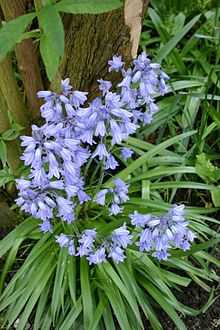Hyacinthoides hispanica
| Hyacinthoides hispanica | |
|---|---|
 | |
| Scientific classification | |
| Kingdom: | Plantae |
| Clade: | Angiosperms |
| Clade: | Monocots |
| Order: | Asparagales |
| Family: | Asparagaceae |
| Subfamily: | Scilloideae |
| Genus: | Hyacinthoides |
| Species: | H. hispanica |
| Binomial name | |
| Hyacinthoides hispanica (Mill.) Chouard ex Rothm. | |
Hyacinthoides hispanica (syn. Endymion hispanicus or Scilla hispanica), the Spanish bluebell, is a spring-flowering bulbous perennial native to the Iberian Peninsula. It is one of around 11 species in the genus Hyacinthoides, others including the common bluebell (Hyacinthoides non-scripta) in northwestern Europe, and the Italian bluebell (Hyacinthoides italica) further east in the Mediterranean region.[1]
It is distinguished from the common bluebell by its paler, larger blue flowers, more erect flower stem (raceme), broader leaves, blue anthers (where the common bluebell has creamy-white ones) and little or no scent compared to the strong fragrant scent of the northern species.
The Spanish bluebell was introduced in the United Kingdom, where it has become an invasive species. The two species hybridise freely, and the resulting hybrid Hyacinthoides × massartiana and the Spanish bluebell both produce highly fertile seed and can invade areas of the native common bluebell. This has caused the common bluebell to be viewed as a threatened species.
The Spanish bluebell is also cultivated as a garden plant, and several named cultivars exist with flowers in various shades of white, pink and blue.
References
- ↑ World Checklist of Selected Plant Families, The Board of Trustees of the Royal Botanic Gardens, Kew, retrieved 2011-07-05, search for "Hyacinthoides"
References
- The-Tree.org: Bluebell (includes key to identification of hybrids)
- Huxley, A. (1992). New RHS Dictionary of Gardening vol. 2: 604. Macmillan.
External links
 Media related to Hyacinthoides hispanica at Wikimedia Commons
Media related to Hyacinthoides hispanica at Wikimedia Commons